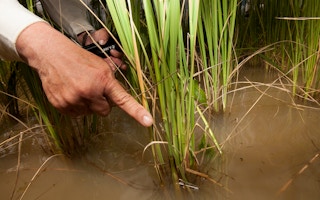A warming planet will see larger swarms of hungrier insects chomp through millions more tons of rice, maize and wheat crops globally by 2050, even if countries meet ambitious climate goals to curb carbon emissions, scientists said on Thursday.
For every one degree Celsius (1.8F) rise in average temperatures, insects will consume an extra 2.5 per cent of the world’s rice, maize and wheat crops, researchers said.
That means a 2-degree Celsius rise in surface temperature would see a total loss of 213 million tons of these staple crops - up from 166 million tons today - according to the study published in the journal Science.
“Temperate regions are currently cooler than what’s optimal for most insects. But if temperatures rise, these insect populations will grow faster,” said co-author Scott Merrill, a researcher at the University of Vermont.
“They will also need to eat more, because rising temperatures also increase insect metabolism. Together, that’s not good for crops,” he said in a statement.
Researchers said higher temperatures would see food prices rise, with the poor most affected.
Globally, one in nine people already lack enough food, and the world’s population is expected to reach 9.8 billion by 2050, the United Nations says.
Most of the world relies on maize, rice or wheat, and demand for these crops is projected to increase by a third by 2050, according to the U.N. Food and Agriculture Organization.
Using climate projection data, crop yield statistics and insect metabolic rates, the study concluded that Europe - the world’s most productive wheat-growing region - could see up to 16 million tons of wheat lost to crop-chomping pests by 2050.
The United States, the world’s largest maize producer, is projected to see its maize-loss rise 40 per cent - or by about 20 million tons each year.
“
Temperate regions are currently cooler than what’s optimal for most insects. But if temperatures rise, these insect populations will grow faster.
Scott Merrill, co-author and researcher, University of Vermont
Insects are also predicted to eat about 27 million tons of rice annually in China, where a third of all rice is produced, the report said.
“Our choice now is not whether or not we will allow warming to occur, but how much warming we’re willing to tolerate,” said Curtis Deutsch from the University of Washington.
In 2015, countries signing the Paris Agreement set a goal of limiting a rise in average world surface temperatures to “well below” 2C (3.6F) above pre-industrial times, while “pursuing efforts” to limit rising temperatures to 1.5C (2.7F).
But even if these climate goals are met, the insects’ appetites will be harder to curb.
“Under virtually all climate change scenarios, pest populations will be the winners, particularly in highly productive temperate regions, causing real food prices to rise and food-insecure families to suffer,” said co-author Rosamond Naylor from Stanford University in a statement.
This story was published with permission from Thomson Reuters Foundation, the charitable arm of Thomson Reuters, that covers humanitarian news, women’s rights, trafficking, property rights, climate change and resilience. Visit http://news.trust.org)

















